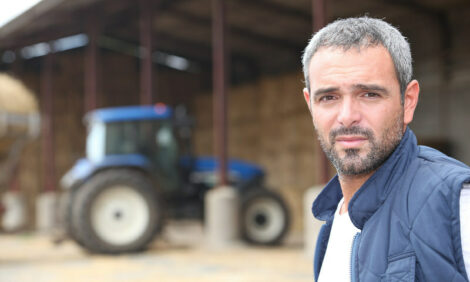



Hog Report more positive than the trade estimates
US - Glenn Grimes and Ron Plain comment on the December 2004 Quarterly Hog and Pigs Report.
 Ron Plain |
The December Hogs and Pigs report came in more positive than the trade estimates. The USDA estimate of all hogs and pigs on farms December 1 (100% of a year earlier) was about 1 1/2% smaller than the average of the trade estimates. The breeding herd at a little over 99% of 2003 was nearly 2% below the trade estimates and the market herd at about 100% of a year ago was also about 1 1/2% below the trade estimates (Table 1).
The report was about 1% below our estimates on all three categories. The breeding herd came in at 99.3% of the 2003 number, and sow and gilt slaughter came in at almost exactly even with the USDA 2003 estimate. We never argue with a 1% difference. Both estimates have a potentially higher sampling error than 1%.
For the first 11 months of 2004, live hog demand was up 12% from 12 months earlier. The big unknown is what demand for live hogs will be for the next 12 months. The market inventories and farrowing intentions indicate a slaughter slightly larger than during the past 12 months. For 2005, an increase in slaughter is expected in the first and third quarters with second and fourth quarter slaughter down a little compared to these periods in 2004. Live hog imports and productivity growth could, and likely will, contribute to some deviation from these estimates.
With farrowing intentions 101% of a year ago for December-February from a breeding herd that is nearly 1% below December 2003 suggests quite healthy productivity growth in this quarter from an increase in the litters per animal in the breeding herd. March-May farrowing intentions show roughly the same number of litters per animal in the breeding herd as a year earlier. The increase in pigs per litter and weights could add some tonnage to the total supply of pork in 2005.
Pork exports for January-October 2004 were 2.5% above total pork exports for the entire year of 2003. With this much growth in the first 10 months of 2004, it will be challenging to get the 14th consecutive year of record high exports in 2005, but it is possible.
Our current estimate is for pork supplies in 2005 to hold close to the 2004 level on a per capita basis.
The continued uncertainty about BSE and what the disease will do to imports of live cattle and exports of beef could be a demand-changing factor for pork The demand for beef in the U.S. appeared to be holding strong through November. We look for domestic beef supplies to be reduced some by building of the cow herd in 2005. Will this potential reduction be large enough to offset the probable increase in live cattle imports and continued large imports of beef by the U.S.? If the Japanese beef market is opened during the first half of the year to the U.S. and Canada, beef supplies in the U.S. on a per capita basis may be smaller in 2005.
Our estimate for hog slaughter in the first quarter of 2005 based on market inventories is for an increase of 1.1% over the first quarter of 2004. With this level of slaughter and a demand for live hogs stable with the fourth quarter, we expect 51-52% lean hogs, live U.S. basis, to average $50-53 per cwt. (Table 4) For the second quarter we estimate slaughter to be down a little over 0.5% from a year ago. Again, with stable demand we expect live prices for 51-52% lean hogs, U.S. basis, to average $52-55 per cwt. live.
The farrowing intentions for December-February indicate a 1% increase in the number of sows farrowing. Our estimates are not building any productivity growth into third quarter 2005 slaughter. We believe marketings were pulled forward in the latter portion of the July-September quarter of 2004.
Commercial hog slaughter in the second quarter of 2004 was up 3.4% from 2003, and third quarter slaughter was up 4.3% from a year earlier. The fourth quarter 2004 slaughter estimate was down more than 1% from the same quarter in 2003, but some or all of the decline was due to having one less slaughter day in the fourth quarter of 2004 than 2003.
Cold storage stocks at the end of November were 2% below a year earlier. However, both chicken and beef cold storage stocks on November 30 were above a year ago.
Unless a slaughter plant or two goes off-line for some reason, the probabilities are very low that the industry will run into slaughter capacity problems in 2005.
Gilt slaughter data continues to indicate no building of the breeding herd through last week. This certainly is not the time to start building the breeding herd for at least two reasons: (1) productivity growth is likely to run 2% or more through the next few years, and (2) history would suggest we are probably too optimistic about demand for all meats in the next year.
Trade reports indicate that the popularity of the low carb diets is declining. As of November, we cannot measure a decline in meat demand, either at the live level for hogs or at the retail level for beef or pork.
Slaughter in the fourth quarter was close to expectations based on the September Hogs and Pigs report, but slaughter estimates for December appear to be large compared to the 180 lb. and heavier market inventory number for December 1.
Our estimates for slaughter and prices for the year of 2005 are in Table 4.
Table 1. Hog Inventories December 1, U.S. ______________________________________________________________ 2004 as % of 2003 Market 100 Kept for breeding 99 All hogs and pigs 100 ______________________________________________________________ Table 2. Market Hogs on Farms December 1, U.S. ____________________________________________________________ Weight Category 2004 as % of 2003 Under 60 pounds 99 60 - 119 pounds 102 120 - 179 pounds 102 180 pounds and over 99 _____________________________________________________________ Table 3. Sows Farrowing and Intentions, U.S. _____________________________________________________________ 2004 as % of 2003 June-August 99 September-November 100 2005 as % of 2004 December-February 101 March-May 100 ____________________________________________________________ Table 4. Estimated Commercial Hog Slaughter by Quarter and Live Hog Prices 1998-2005 ___________________________________________________________________________ Commercial Terminal Mkt. 51-52% Lean Non-packer-sold Slaughter Barrow & Gilt Hogs Hogs (avg. net Period (mil. hd.) (price/cwt.) (price/cwt.) carcass price/cwt) ___________________________________________________________________________ 1998 Year 101.029 31.82 1999 1 25.579 $26.55 $28.83 2 24.288 33.06 35.18 3 24.953 32.78 35.70 4 26.724 33.88 36.29 Year 101.544 31.57 34.01 2000 1 25.039 $39.11 $41.14 2 23.125 47.99 50.43 3 24.097 44.19 46.44 4 25.715 38.33 40.78 Year 97.976 42.41 44.70 2001 1 24.578 $40.77 $42.83 2 23.280 50.21 52.05 3 23.635 48.04 51.05 4 26.469 34.97 37.30 $51.67 Year 97.962 43.50 45.81 n/a 2002 1 24.148 $37.23 $39.43 $54.25 2 24.280 32.77 34.99 50.43 3 25.120 31.09 33.86 49.66 4 26.715 28.52 31.34 46.10 Year 100.263 32.40 34.91 50.09 2003 1 24.654 $33.32 $35.38 $50.40 2 23.922 39.86 42.64 58.92 3 24.747 38.66 42.90 59.27 4 27.608 34.15 36.89 52.36 Year 100.931 36.50 39.45 55.25 2004 1 25.714 $40.82 $44.18 $60.56 2 24.736 51.56 54.91 $72.74 3 25.813 53.72 56.58 74.73 4 (part. est.) 27.286 50.80 54.75 71.50 Year (proj.) 103.549 49.23 52.60 69.88 2005 1 (projected) 26.000 47 - 50 50 - 53 66 - 71 2 (projected) 24.600 49 - 52 52 - 55 69 - 74 3 (projected) 26.050 47 - 50 50 - 53 67 - 72 4 (projected) 27.000 45 - 48 48 - 51 66 - 71 Year (proj.) 103.650 47 - 50 50 - 53 67 - 72 |








